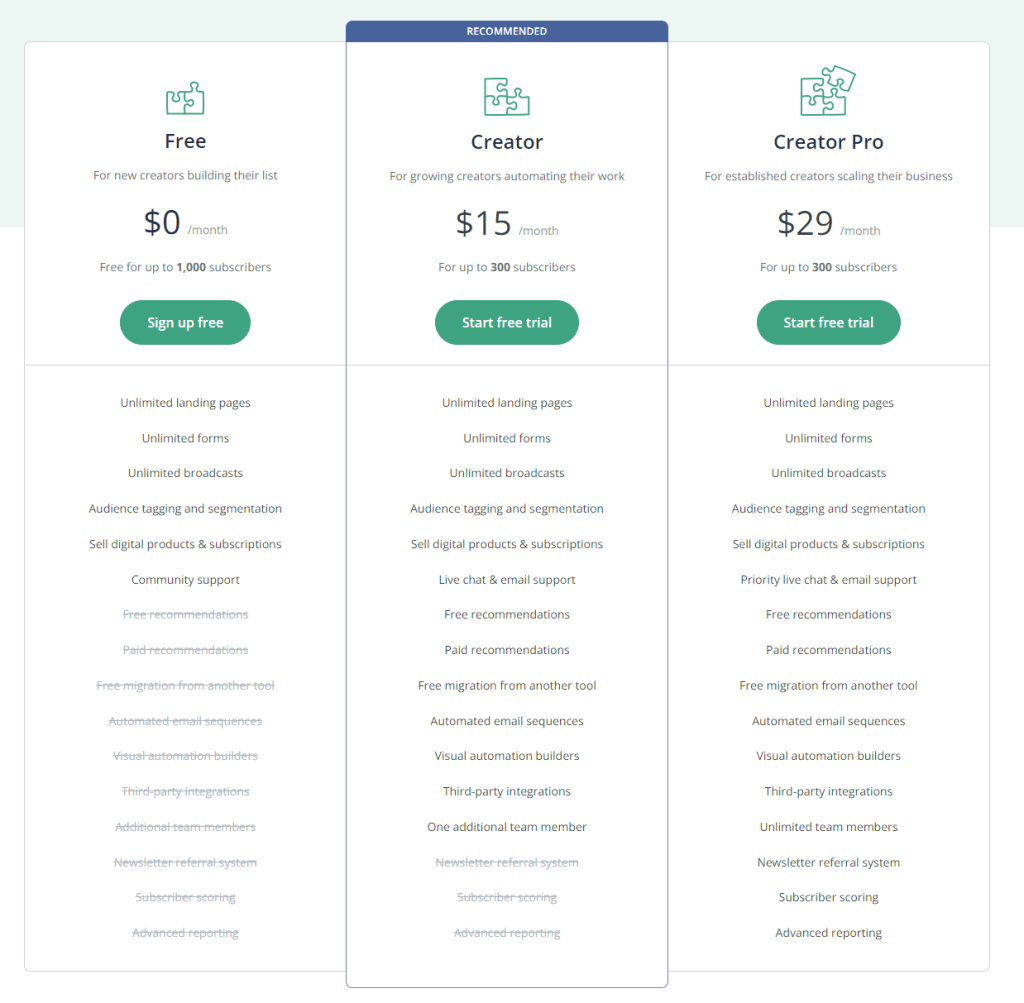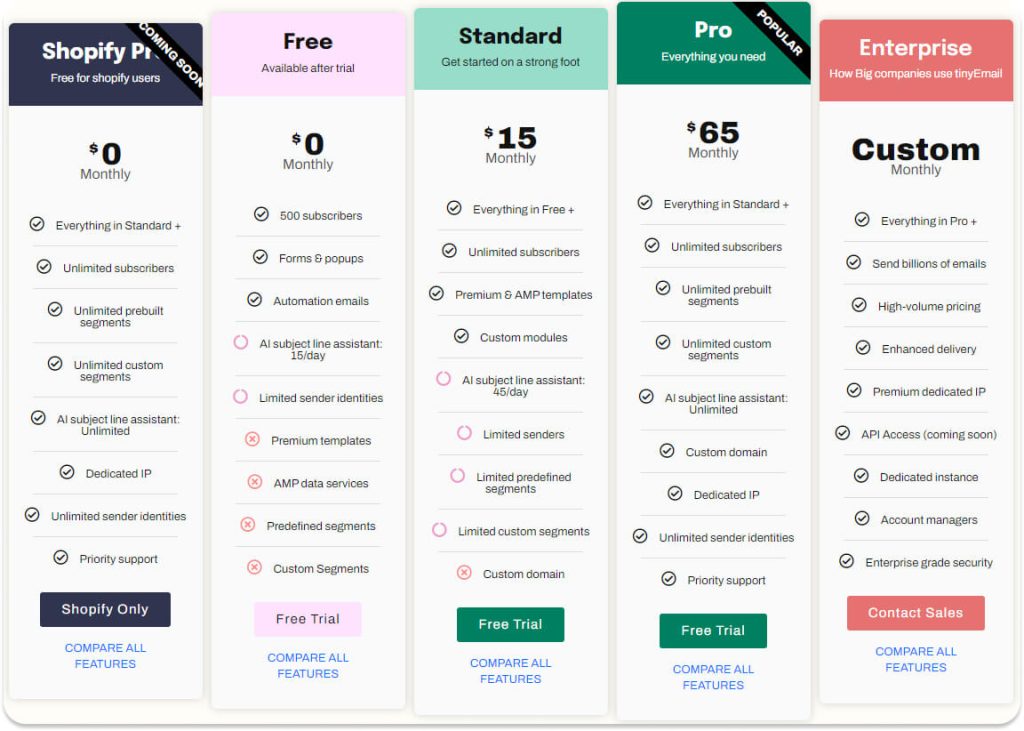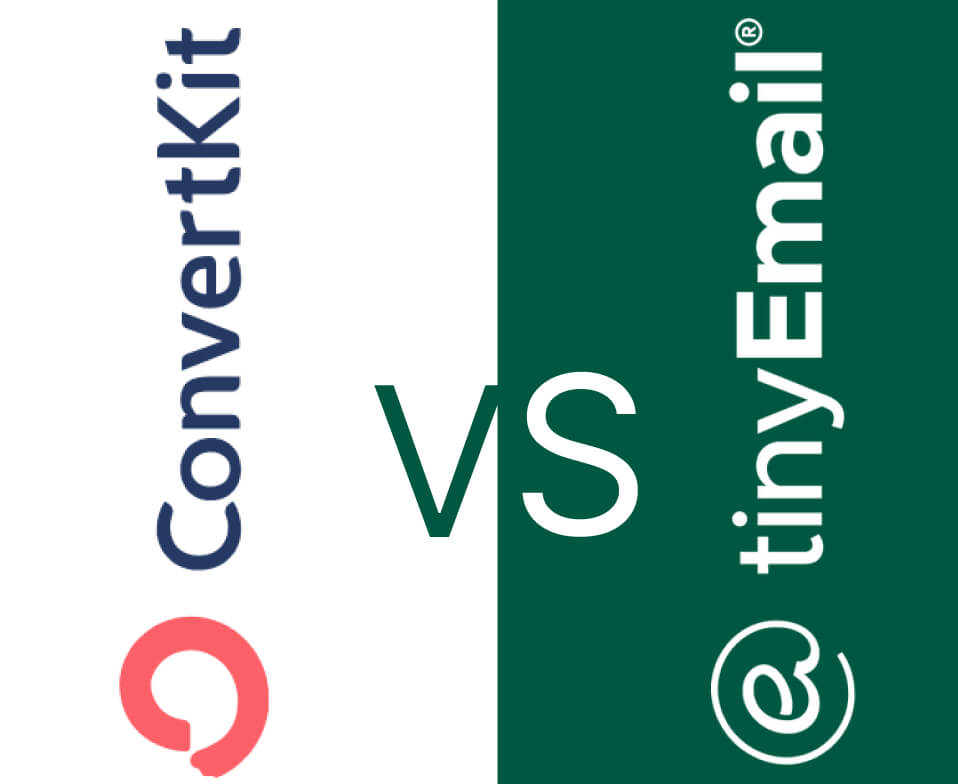ConvertKit vs TinyEmail, the two email marketing tools for your need. Are you tired of the email marketing tool you are currently using or you are starting off and need an email marketing tool.
In this article, we will compare ConvertKit vs TinyEmail, two popular email marketing platforms, to help you determine which one is better suited for your needs. We will evaluate their key features,pricing, functionality, and other aspects to help you make an informed decision.
Convertkit was established in 2013 with the goal of giving bloggers, small companies, and content creators easy-to-use tools for growing their email lists and engaging their audience. Convertkit makes audience segmentation and campaign design simple with its user-friendly UI and automated features.
Tinyemail on other hand is Relatively new to the email marketing scene, TinyEmail debuted in 2020 and offers a beautiful, contemporary style. Businesses can create stunning emails that generate results with TinyEmail’s emphasis on aesthetics, automation, and integration.
Table of Contents
ConvertKit vs TinyEmail : Market Position and Target Audience
ConvertKit vs TinyEmail have distinct market positions and target audiences. ConvertKit is more popular among creators, bloggers, and online course businesses, offering a robust platform tailored for seamless audience engagement and advanced automation features. On the other hand, TinyEmail caters to smaller operations and content creators looking for an intuitive and user-friendly email solution, with a focus on simplicity and modern design.
The debate between ConvertKit vs TinyEmail has been gaining traction, with both platforms carving a niche for themselves in the crowded marketplace. ConvertKit’s rich history and user-friendly tools have made it a favorite among bloggers and content creators, while TinyEmail’s modern design, cloud infrastructure, and emphasis on adaptability have attracted users looking for a future-ready email marketing solution
ConvertKit vs TinyEmail : Features and Functionality
Ease of Use
TinyEmail is known for its simplicity and ease of use, making it a quick path to proficiency. The platform’s pared-down approach focused on simplicity reduces the barrier to entry, especially for those with basic email marketing needs. On the other hand, ConvertKit, while powerful, requires more learning investment due to its advanced automation features and comprehensive suite of tools
.
The user-friendly interface and minimal learning curve of TinyEmail make it an ideal pick for those just starting out in email marketing. It offers all the essentials to design and send compelling email campaigns, making it a favorite for users who prioritize ease of use and quick proficiency
.
In contrast, ConvertKit’s focus on providing a robust platform tailored for creators and online course businesses comes with a steeper learning curve. The platform’s advanced automation capabilities and extensive features require users to invest more time in learning the ins and outs of the software
.
Ultimately, the choice between TinyEmail vs ConvertKit in terms of ease of use depends on the user’s specific needs, level of expertise, and preference for simplicity versus advanced functionality. While TinyEmail excels in providing a straightforward and user-friendly experience, ConvertKit offers a more powerful but complex solution that may require a greater learning investment
Email Deliverability
Email deliverability is a crucial aspect of email marketing, and both ConvertKit vs TinyEmail have different approaches to it. ConvertKit focuses heavily on deliverability, with dedicated IP addresses and inbox placement tools, maintaining an excellent sender reputation. The platform inboxes at over 99% on average and offers deliverability guarantees. Emails comply with CAN-SPAM and GDPR regulations, and for advanced deliverability, ConvertKit provides ISP relationship management and inbox rendering previews
.
On the other hand, TinyEmail has mixed reviews when it comes to deliverability, with some users praising its affordability and ease of use, but others complaining about limitations for growing businesses. TinyEmail does not publish detailed deliverability metrics, but it states that inboxing rates average over 90%. As a newer and smaller provider, TinyEmail does not have the long-standing reputation of ConvertKit, and there is room for growth to better serve users
.
In summary, ConvertKit’s focus on deliverability and maintaining an excellent sender reputation makes it a clear winner in this category. Its dedicated deliverability tools and expertise, 99%+ inboxing rates, and established sender reputation make it a reliable choice for businesses looking to ensure their emails reach their intended audience. While TinyEmail’s inboxing rates are decent, its shorter history puts it behind on optimizing for the inbox
Automation
ConvertKit vs TinyEmail offer distinct automation features, catering to different user needs. ConvertKit provides a comprehensive suite of automation tools, including advanced features such as welcome campaigns, browse abandonment flows, and email nurturing sequences. Its workflows can be based on criteria like email engagement, purchase activity, and date-based events, empowering businesses to create complex automated email sequences and personalized content for their subscribers
.
On the other hand, TinyEmail has a more limited range of automation features compared to ConvertKit. While it offers basic features like welcome emails and RSS-to-email campaigns, its automation capabilities are not as advanced as those of ConvertKit. However, TinyEmail’s straightforward approach and minimal learning curve make it an ideal choice for users who value simplicity and functionality over complex automation tools
.
In summary, ConvertKit stands out for its robust and advanced automation features, making it a preferred choice for businesses and creators looking to implement sophisticated automated email campaigns and personalized content. In contrast, TinyEmail’s more basic automation features are suitable for users who prioritize ease of use and quick proficiency over advanced automation capabilities
Integration
ConvertKit vs TinyEmail both offer a variety of integrations to enhance their functionality, but ConvertKit boasts a more extensive list of third-party integrations. ConvertKit’s integrations cover a wide range of categories, including e-commerce, lead capture, analytics, and website platforms. The platform provides seamless integration with popular tools such as Mighty Networks, Databox, Shopify, WooCommerce, and many more, enabling users to connect their email marketing efforts with other essential business systems
On the other hand, while TinyEmail also offers integrations with key tools and platforms, its integration ecosystem is not as extensive as ConvertKit’s. TinyEmail’s integrations cover essential areas such as lead capture, e-commerce, and analytics, but the platform may have limitations in terms of the number and diversity of integrations compared to ConvertKit
ConvertKit’s robust integration capabilities allow users to streamline their workflows, automate tasks, and leverage data from various sources to enhance their email marketing campaigns. The platform’s integration with Zapier further extends its connectivity, enabling users to link ConvertKit with thousands of other apps and automate various processes without the need for extensive coding
In summary, while both ConvertKit and TinyEmail offer valuable integrations, ConvertKit’s more extensive and diverse integration ecosystem provides users with a broader range of options to seamlessly connect their email marketing activities with other business tools and systems, ultimately enhancing their overall marketing effectiveness and efficiency
ConvertKit vs TinyEmail : Customer Support
Both ConvertKit vs TinyEmail offer round-the-clock support and resources to their users, but they differ in their approach to customer support and training.
ConvertKit takes pride in its swift and responsive customer support, offering 24/7 live chat support and an extensive knowledge base. Users can find solutions to their queries in real-time or delve into articles and tutorials for self-help. ConvertKit also conducts regular webinars and workshops, keeping its user base updated on the platform’s latest features and best practices
In contrast, TinyEmail has a community-driven approach to customer support, with a rich resource center and a user forum where users can ask questions and share ideas. The platform’s resource center provides a wealth of information on email marketing best practices, design tips, and other relevant topics. TinyEmail also offers email support, but its response time may not be as fast as ConvertKit’s
When it comes to training, ConvertKit provides more extensive training sessions, including webinars, workshops, and courses, to help users master the platform’s advanced features. The platform’s training resources cover topics such as email marketing strategy, automation, and list building, empowering users to create effective email campaigns and grow their businesses. In contrast, TinyEmail’s training resources are more limited, with a focus on getting started and basic email marketing concepts
In summary, both ConvertKit and TinyEmail offer valuable customer support and resources, but their approach differs. ConvertKit provides more extensive training resources and responsive customer support, making it a reliable choice for businesses and individuals looking for comprehensive assistance. In contrast, TinyEmail’s community-driven approach and rich resource center make it an ideal choice for users who value a collaborative and supportive community
ConvertKit vs TinyEmail : Pricing and Plan
When comparing the pricing and plans of ConvertKit vs TinyEmail, several key factors come into play.
ConvertKit offers a tiered pricing structure, starting at $29 per month for up to 3,000 subscribers. The pricing scales with the number of subscribers, and the platform provides a free plan for users with up to 1,000 subscribers. This freemium model is advantageous for those just starting out, allowing them to manage a small subscriber base without incurring charges

.
On the other hand, TinyEmail’s pricing is competitive, starting at $15 per month for up to 500 subscribers. The platform also offers discounts for annual plans and higher volumes, making it an attractive option for small businesses and individuals with limited budgets

.
When considering the pricing and plans of ConvertKit vs. TinyEmail, it’s essential to evaluate the features and capabilities offered at each price point. ConvertKit’s higher pricing tiers provide access to advanced automation features, landing pages, and integrations, making it suitable for businesses focused on growth and scalability. In contrast, TinyEmail’s affordable entry pricing and straightforward plans make it a budget-friendly choice for very small lists, but costs can scale quickly for larger subscriber bases and additional functionality
People also read:
AWeber vs TinyEmail: Making the Right Choice
MailerLite vs Flodesk – Decoding the Best Email Marketing Platform
ConvertKit vs TinyEmail : Scalability
When it comes to scalability, both ConvertKit vs TinyEmail offer scalable solutions, making them suitable for businesses at different stages of growth. ConvertKit, with its established reputation and adaptive plans, is a reliable choice for businesses anticipating growth. The platform’s tiered pricing structure and feature set cater to the evolving needs of users, allowing them to seamlessly transition to higher tiers as their subscriber base and email marketing requirements expand.
On the other hand, TinyEmail’s flexible and modern design makes it a promising option for those who prioritize adaptability and future readiness. The platform’s competitive pricing and user-friendly interface position it as an attractive choice for small to medium-sized businesses looking to scale their email marketing efforts. While TinyEmail may have limitations in terms of advanced features compared to ConvertKit, its emphasis on simplicity and affordability makes it an appealing option for users seeking a straightforward and cost-effective solution for their evolving needs
ConvertKit vs TinyEmail : Pros and Cons
ConvertKit
Pros:
User-friendly interface and intuitive design
Robust automation capabilities
Comprehensive set of educational resources
Swift and responsive customer support
Seamless scalability for growing businesses
Cons:
Higher pricing, especially for larger subscriber bases
Limited email sending on lower-tier plans
May have a steeper learning curve due to advanced features
TinyEmail
Pros:
Contemporary design and user-friendly interface
Competitive pricing, especially for small subscriber bases
24/7 customer support via email and chat
Straightforward approach and minimal learning curve
Cons:
Limited email sending on lower-tier plans
Less extensive educational resources compared to ConvertKit
May have limitations in advanced automation features
Conclusion
In conclusion, the choice between ConvertKit vs TinyEmail depends on the user’s specific needs, budget, and growth projections. ConvertKit’s transparent pricing, freemium model, and robust features make it a compelling choice for businesses and creators looking for a comprehensive email marketing solution. On the other hand, TinyEmail’s competitive pricing and budget-friendly plans cater to small businesses and individuals with limited resources, offering a simple and cost-effective platform to kickstart their email marketing efforts.
Frequently Asked Questions (FAQ) For ConvertKit vs TinyEmail
- What are ConvertKit and TinyEmail?
- ConvertKit vs TinyEmail are popular email marketing platforms designed to help businesses and individuals create, send, and manage email campaigns, and engage with their subscribers.
- What are the key features of ConvertKit and TinyEmail?
- ConvertKit offers a user-friendly interface, robust automation capabilities, comprehensive educational resources, and seamless scalability. On the other hand, TinyEmail provides a contemporary design, competitive pricing, 24/7 customer support, and a straightforward approach.
- How do ConvertKit and TinyEmail differ in terms of target audience?
- ConvertKit is more popular among creators, bloggers, and online course businesses, offering advanced automation features and a robust platform tailored for seamless audience engagement. In contrast, TinyEmail caters to smaller operations and content creators looking for an intuitive and user-friendly email solution, with a focus on simplicity and modern design.
- What are the pricing and plans offered by ConvertKit and TinyEmail?
- ConvertKit offers a tiered pricing structure, starting at $29 per month for up to 3,000 subscribers, with a free plan for users with up to 1,000 subscribers. TinyEmail’s pricing is competitive, starting at $15 per month for up to 500 subscribers, with discounts for annual plans and higher volumes.
- Which platform is more suitable for businesses with growth in their forecast?
- ConvertKit’s transparent pricing, freemium model, and robust features make it a compelling choice for businesses and creators looking for a comprehensive email marketing solution. However, TinyEmail’s competitive pricing and budget-friendly plans cater to small businesses and individuals with limited resources, offering a simple and cost-effective platform to kickstart their email marketing efforts.
- What are the key factors to consider when choosing between ConvertKit and TinyEmail?
- The choice between ConvertKit vs TinyEmail depends on the user’s specific needs, budget, and growth projections. ConvertKit’s advanced automation features, extensive educational resources, and responsive customer support make it suitable for businesses focused on growth and scalability. In contrast, TinyEmail’s competitive pricing, user-friendly interface, and straightforward approach make it an appealing choice for small to medium-sized businesses and individuals looking for a cost-effective email marketing solution.
- How do ConvertKit and TinyEmail differ in terms of email deliverability?
- ConvertKit focuses heavily on deliverability, with dedicated IP addresses and inbox placement tools, maintaining an excellent sender reputation. On the other hand, TinyEmail has mixed reviews when it comes to deliverability, with some users praising its affordability and ease of use, but others expressing concerns about limitations for growing businesses.
- What are the pros and cons of ConvertKit and TinyEmail?
- ConvertKit’s pros include a user-friendly interface, robust automation capabilities, comprehensive educational resources, and seamless scalability. However, it has higher pricing, especially for larger subscriber bases, and may have a steeper learning curve due to advanced features. On the other hand, TinyEmail’s pros include a contemporary design, competitive pricing, 24/7 customer support, and a straightforward approach. Its cons include limited email sending on lower-tier plans and less extensive educational resources compared to ConvertKit.
- How do ConvertKit and TinyEmail differ in terms of integrations?
- ConvertKit provides a more extensive list of third-party integrations, covering a wide range of categories, including e-commerce, lead capture, analytics, and website platforms. In contrast, while TinyEmail also offers integrations with key tools and platforms, its integration ecosystem is not as extensive as ConvertKit’s.
- Which platform is more suitable for users who prioritize adaptability and future readiness?
- TinyEmail’s flexible and modern design makes it a promising option for those who prioritize adaptability and future readiness. The platform’s competitive pricing and user-friendly interface position it as an attractive choice for small to medium-sized businesses looking to scale their email marketing efforts.





Pingback: MailerLite vs Flodesk - Decoding the Best Email Marketing Platform - software tool hub